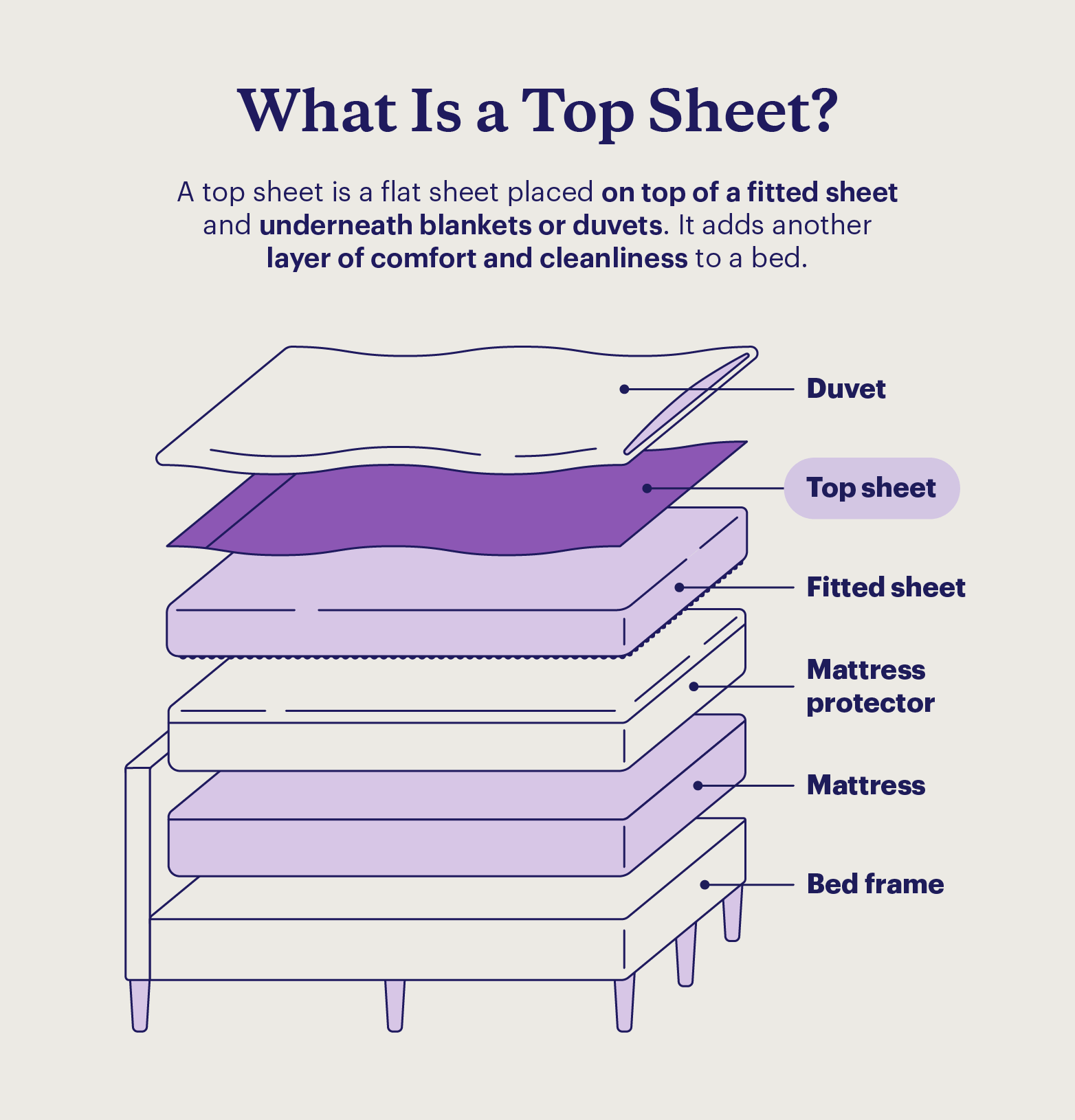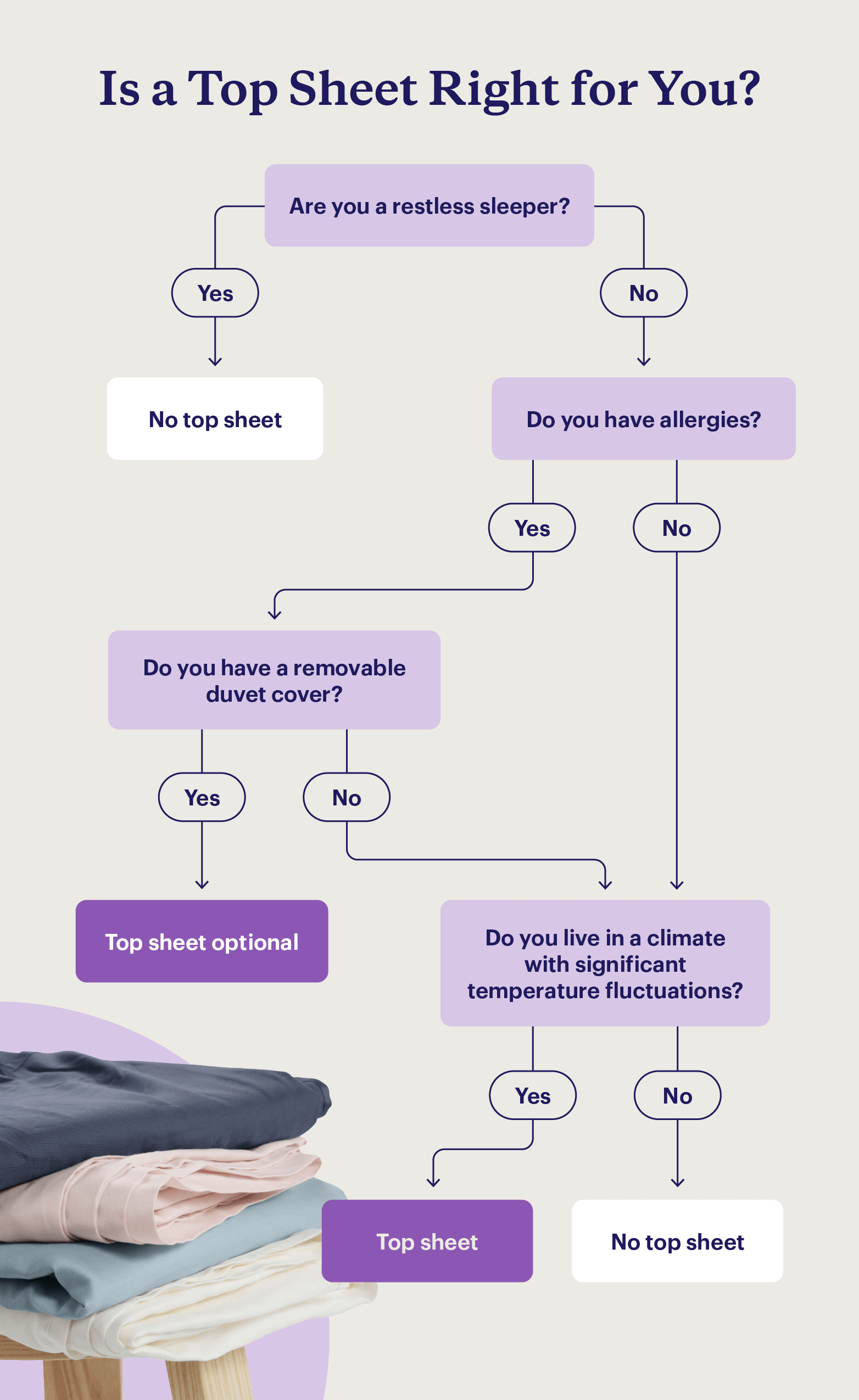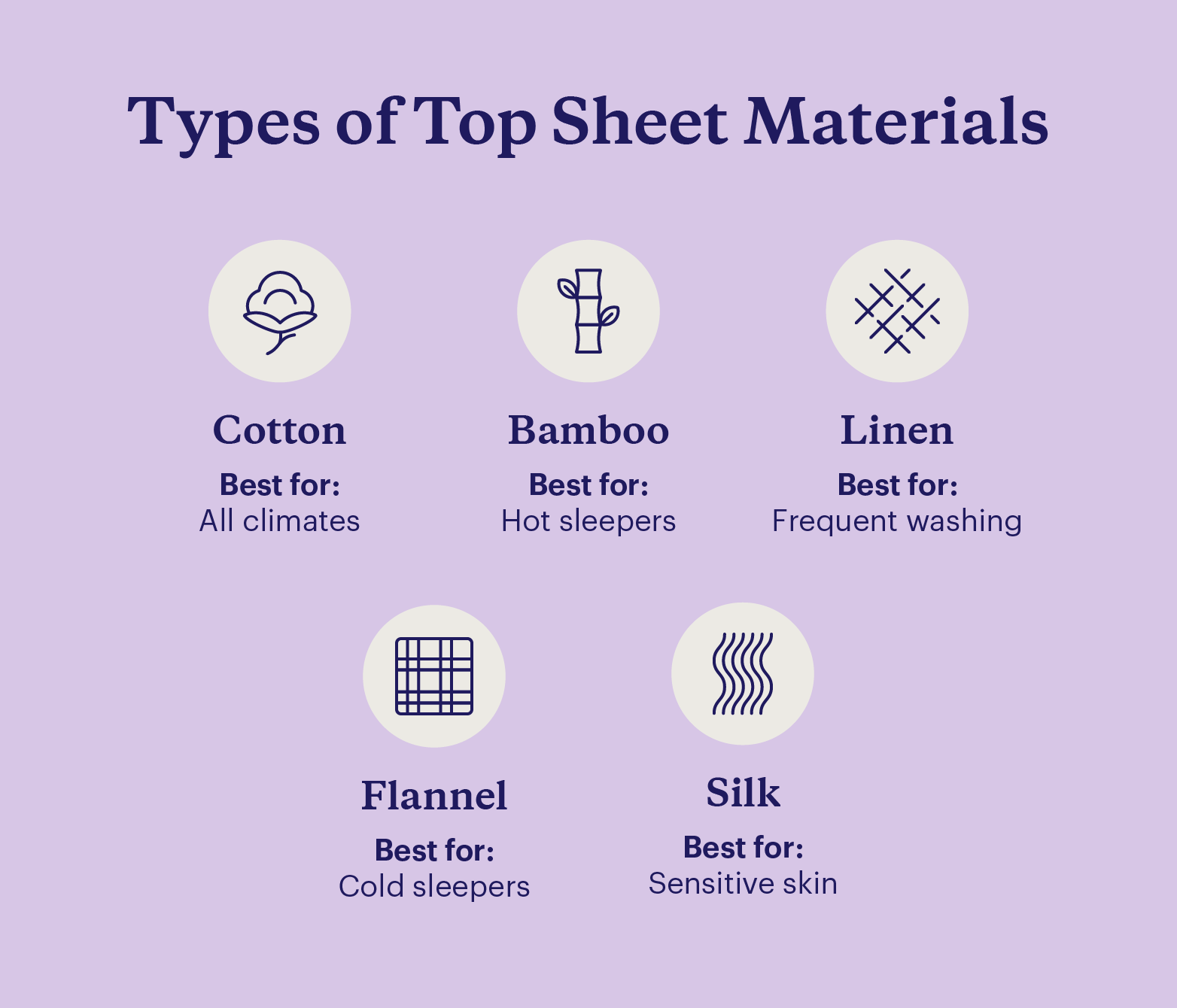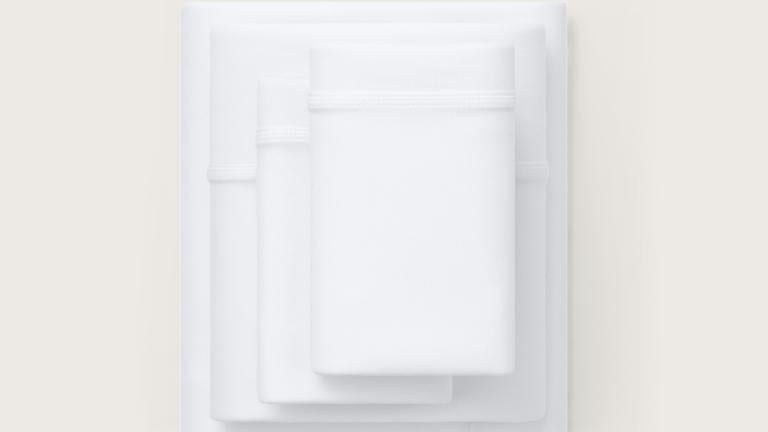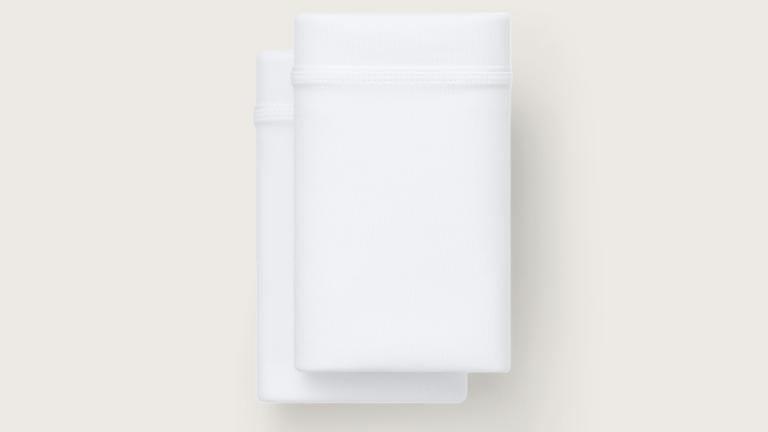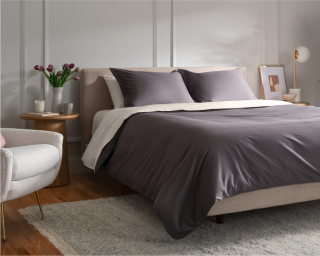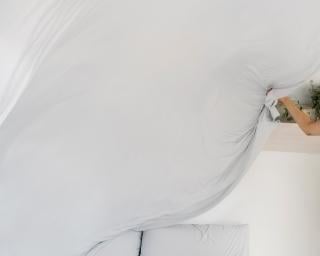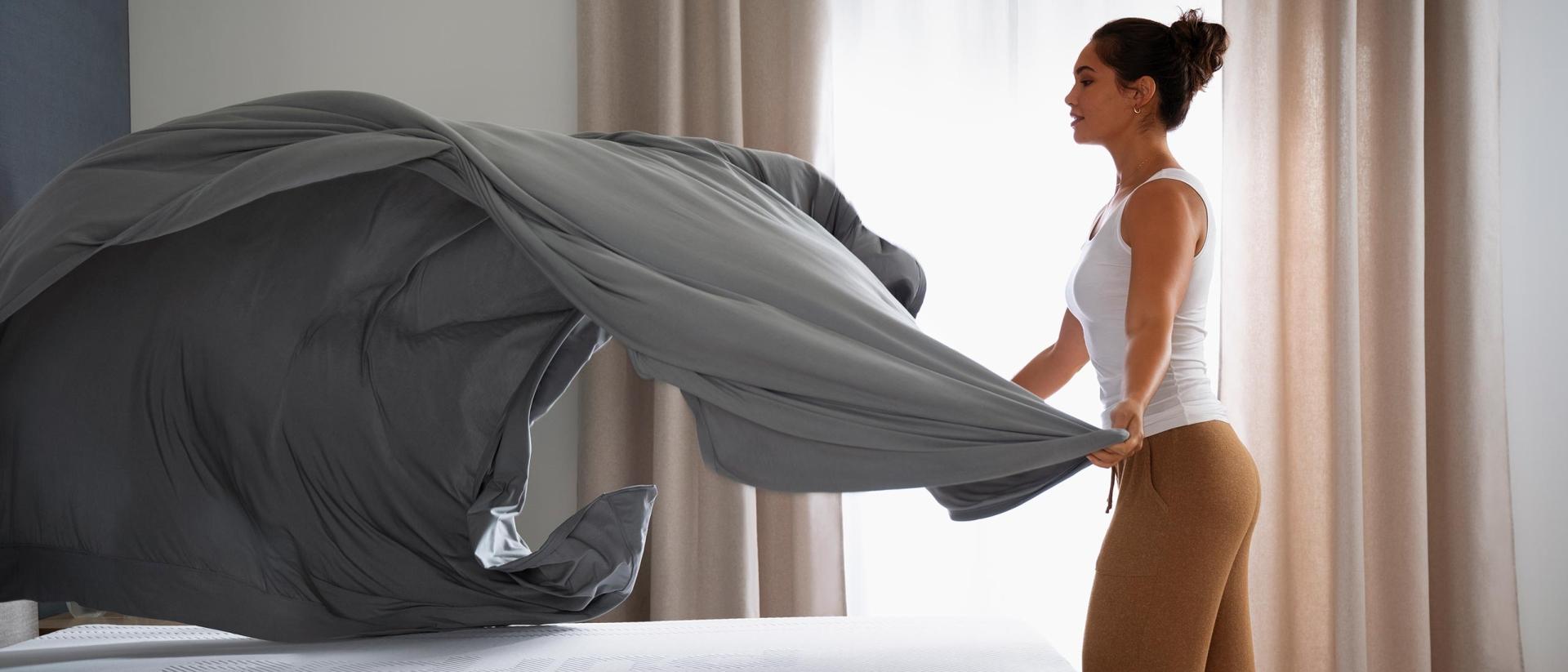
What Is a Top Sheet? Why You Might (or Might Not) Use One
What is a top sheet?
A top sheet, also known as a flat sheet, is a rectangular piece of bedding placed between the fitted sheet and your blanket or duvet.
What used to be a guaranteed component in any bedding setup has become somewhat of a controversial debate in recent years: top sheets. In fact, nearly one-third of Americans have ditched top sheets completely.
You either hate them or you can’t live without them, but what exactly is their purpose?
Read on to learn exactly what a top sheet is, how it compares to a fitted sheet, the pros and cons of using one, and how to choose the right type of bed sheet.
What Is a Top Sheet?
A top sheet (or flat sheet) is a type of bed sheet that’s placed on top of a fitted sheet and underneath blankets or a duvet.
Its primary purpose is to act as a lightweight, washable barrier between you and your heavier bedding. This helps maintain hygiene, regulate temperature, and add a soft, breathable layer while you sleep.
In traditional bed setups, the top sheet is considered essential. However, today’s preferences vary based on convenience, comfort, and climate.
Top Sheet vs. Fitted Sheet
A top sheet and a fitted sheet are two bedding components that serve unique purposes.
A fitted sheet has elastic corners designed to snugly cover the mattress and keep it from slipping off. It protects the mattress and provides a smooth, soft surface for you to sleep on.
A top sheet, also called a flat sheet, is placed on top of the fitted sheet and under any blankets or duvets. It acts as an additional layer of comfort and warmth. Top sheets also serve as a barrier between you and your blankets, which keeps them cleaner for longer.
Feature | Top Sheet (Flat Sheet) | Fitted Sheet |
Placement | Between the sleeper and the blanket/duvet | Directly over the mattress |
Design | Flat, rectangular, no elastic | Elastic corners to fit snugly |
Function | Adds comfort, protects duvet or blanket | Protects mattress, provides smooth base |
Pros and Cons of Using a Top Sheet
So what exactly are the advantages of using a top sheet? And are they really necessary for your sleep preferences?
Pros | Cons |
More hygienic | More time-consuming to make the bed |
Easier to clean than heavy bedding | Sometimes an additional bedding cost |
Allows for temperature control | May become tangled during the night |
Extends the lifespan of your bedding | Additional laundry |
Can act as an allergen barrier | May not be necessary with a removable duvet cover
|
Pros of Top Sheets
A top sheet isn’t something included in a sheet set just for kicks. There are several benefits of this bedding addition:
- More hygienic: A top sheet acts as a barrier between you and your heavier bedding, which can accumulate body oils, sweat, and dirt over time.
- Easy to wash: A top sheet is much less bulky than heavy blankets or duvets, making it easier to wash. Most washers can fit a complete sheet set (fitted and top sheets plus pillowcases) in a single load cycle and will use less water than frequently washing heavy blankets.
- Extends bedding lifespan: Since a top sheet protects the rest of your bedding, duvets and blankets are likely to last longer than if you were washing them regularly.
- Better temperature control: Keep cool on hot nights by using just the top sheet, and easily layer bedding on cooler nights.
- Adds comfort: There’s nothing like the feeling of a soft bed sheet, especially if your heavier layers of bedding aren’t as comfortable.
- Acts as an allergen barrier: A top sheet also creates a protective layer that prevents direct contact with potential allergens like dust mites, pet dander, and pollen. This is especially true if you buy specific sheets for allergies, like cotton, silk, or bamboo.
Top sheets are also flexible, in that you can use them as top layers or tuck in the overhang, which can be useful if you’re upgrading from a full to a queen, for example.
Cons of Top Sheets
On the other hand, there are sound reasons why people dislike top sheets. For instance, a top sheet:
- Creates extra work: Although it’s only one extra step, some people may find making the bed with a top sheet more time-consuming.
- Can bunch up: Sheets can get twisted and tangled if you’re a restless sleeper. Some people just end up kicking it to the bottom of the bed throughout the night.
- Adds laundry: A top sheet needs to be washed often for cleanliness and allergy protection. That said, if you aren’t using a top sheet, you should wash your blankets and the rest of your bedding that touches your body while you sleep just as often as you would a top sheet for the same reasons.
- Increases costs: Buying a top sheet can increase the overall cost of bedding, especially for higher thread count or quality materials. It may be less expensive to purchase as part of a bedding set rather than separately or l if you don't want a top sheet and purchase a fitted sheet individually.
Overall, top sheets are optional. Removable duvet covers make bedding less bulky for easier washing. While you still may want to use a top sheet for its other benefits, removable duvet covers can make washing bedding simpler.
Top Sheet Materials
When it comes to choosing bed sheets, the type of sheet material you select makes a big difference in comfort, quality, and how long your sheets will last. Different materials offer unique benefits, catering to the various preferences and needs of every kind of sleeper. Choose from materials like:
- Cotton: Known for breathability and durability, cotton sheets are soft and suitable for all-seasons use.
- Bamboo: If you’re a hot sleeper, bamboo sheets like the Purple SoftStretch® Sheet Set prevent overheating at night. They have moisture-wicking properties and a silky texture to keep you comfortable all night long.
- Linen: Similar to cotton sheets, linen sheets are strong but thicker. Their thickness makes them extra durable and long-lasting.
- Flannel: With a brushed, soft texture, flannel sheets are great for cold winter nights. This is the warmest type of sheet.
- Silk: This type of sheet material is unmatched in terms of smoothness and luxurious feel. Silk sheets are best for people with sensitive skin; however, they might require extra care and may be too slippery for restless sleepers.
Should You Use a Top Sheet?
Ultimately, deciding whether to use a top sheet comes down to personal preference. If you enjoy layered bedding, temperature control, and easier cleaning, a top sheet may be worth keeping. If you prefer minimal bedding or use a duvet cover, skipping it might suit you better.
Most sheet sets, including Purple SoftStretch® Sheets, come with a fitted sheet, top sheet, and pillowcases — giving you the choice to use or lose the top sheet as you see fit.
If you’re ready to ditch the top sheet, you'll need to figure out what to do with your old sheets. But if you’re pro-top sheet, check out our selection of high-quality sheets that are made to last and improve your sleeping comfort.
FAQ
Have a few more questions before you make up your mind on the top sheet debate? Check out the answers to these common bedding questions.
The original purpose of a top sheet was to provide an additional layer of bedding to protect the sleeper from dirt, pests, and other elements, as beds were often less clean and exposed to various environmental factors.
Whether or not you use a top sheet is purely personal preference, but many people still use top sheets as part of their bedding. However, there’s a growing trend toward eliminating the top sheet and only using a fitted sheet and duvet.
The top sheet typically goes finished side down, so the softer or printed side faces you when you're in bed. This way, it looks neat when folded over the blanket and feels more comfortable against your skin.
The main benefit of a top sheet is its ability to add an extra layer of comfort and cleanliness to a bed. It acts as a barrier between the sleeper and the blankets or duvet, helping to keep these heavier items cleaner for longer and keep allergens at bay. A top sheet can also provide extra warmth or be used alone to adapt to warmer temperatures.
It depends on how you like to make your bed.
If you prefer to fold over your duvet or comforter at the head of the bed and keep the top sheet lying flat, you should face the top sheet up so the seam or patterned side shows under your pillows. If you don’t fold your blankets over at all, you can place the top sheet face up as well since your sheets won't be exposed.
But if you fold over the top sheet along with your duvet or comforter, you should face the decorative or seam side down so it shows properly when exposed. That said, if appearance is not a concern, opt to place the softer side of the sheet so it's against your body when you sleep.
More To Explore
Level up your sleep routine with our most-loved products.


